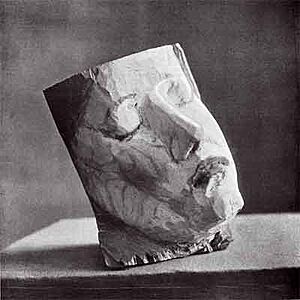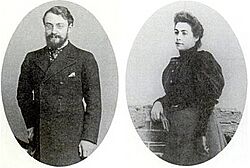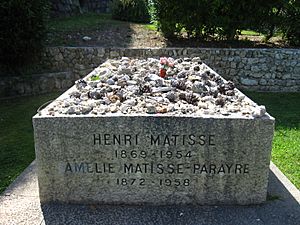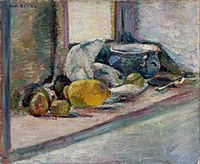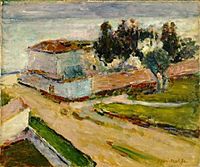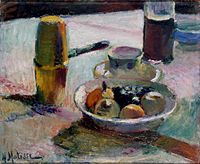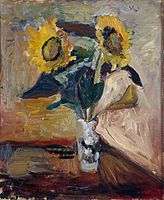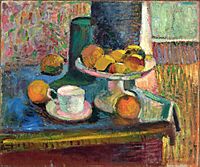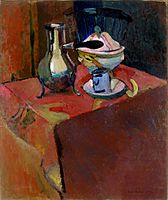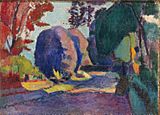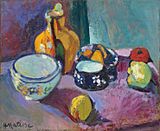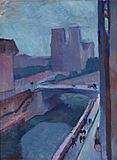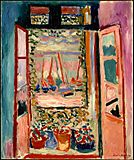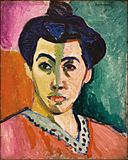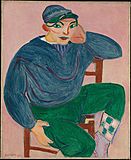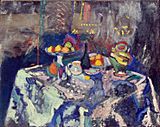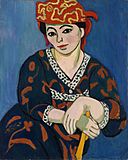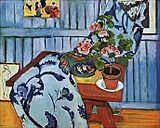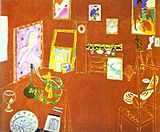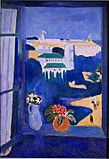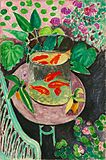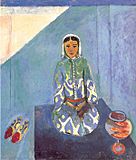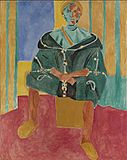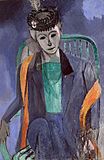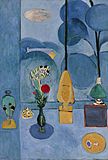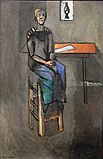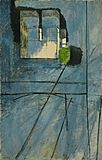Henri Matisse facts for kids
Quick facts for kids
Henri Matisse
|
|
|---|---|

Matisse in 1913
|
|
| Born |
Henri Émile Benoît Matisse
December 31, 1869 Le Cateau-Cambrésis, France
|
| Died | November 3, 1954 (aged 84) Nice, France
|
| Education | Académie Julian, William-Adolphe Bouguereau, Gustave Moreau |
| Known for |
|
|
Notable work
|
Woman with a Hat (1905) The Joy of Life (1906) Nu bleu (1907) La Danse (1909) L'Atelier Rouge (1911) |
| Movement | Fauvism, Modernism, Post-Impressionism |
| Spouse(s) |
Amélie Noellie Parayre
(m. 1898; div. 1939) |
| Patron(s) | Sergei Shchukin, Gertrude Stein, Etta Cone, Claribel Cone, Sarah Stein, Albert C. Barnes |
Henri Matisse (born December 31, 1869 – died November 3, 1954) was a famous French artist. He was known mostly as a painter, but he also created drawings, prints, and sculptures. Matisse is considered one of the most important artists in modern art.
Contents
Early Life and Education

Henri Matisse was born in Le Cateau-Cambrésis, a town in northern France, on New Year's Eve in 1869. He was the oldest son in a family that sold grain. He grew up in a place called Bohain-en-Vermandois.
In 1887, when he was 18, Matisse went to Paris to study law. After finishing his studies, he worked as a court administrator in his hometown.
Discovering Art
Matisse first started painting when he was 20 years old, in 1889. He was recovering from an illness called appendicitis. To make him feel better, his mother brought him art supplies. Painting quickly became "a kind of paradise" for him. He decided then that he wanted to be an artist.
In 1891, he went back to Paris to study art. He learned from famous teachers like William-Adolphe Bouguereau and Gustave Moreau at art schools like the Académie Julian.
Matisse's Art Styles
Painting with Bright Colors
At first, Matisse painted everyday objects and outdoor scenes in a traditional way. But in 1896, he met an Australian painter named John Russell. Russell showed him the art style called Impressionism and the work of his friend Vincent van Gogh. This meeting changed Matisse's art forever. He stopped using dull, earthy colors and started using very bright ones.
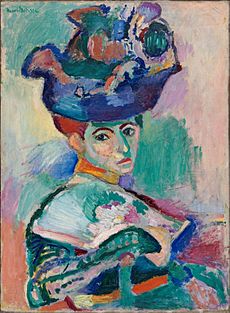
Around 1900, Matisse and another artist, André Derain, started a new art movement called Fauvism. This style was known for using bold, bright colors in unexpected ways. Matisse and Derain were friendly rivals, and each had their own followers. One of Matisse's most famous Fauvist paintings is Woman with a Hat. After 1906, the Fauvist movement became less popular, but Matisse continued to develop his own unique style.
In 1906, Matisse traveled to Algeria to learn about African art. He also spent two months in Spain studying Moorish art, which uses beautiful patterns and designs.
Creating Sculptures
Sometimes, when Matisse was having trouble with a painting, he would make a sculpture instead. He would create a three-dimensional version of what he wanted to paint. Then, he would use the sculpture to help him paint the figure in two dimensions. Matisse made more than seventy sculptures during his life.
Later Art Forms
During World War II, Matisse was still able to show his art in France. He also worked as a graphic artist, making black-and-white pictures for books and over one hundred lithographs (a type of print).
In 1941, Matisse was diagnosed with cancer. Painting and sculpting became difficult for him. So, he started making collages using cut paper. At first, these were small, but eventually, his paper cut-outs became huge, like murals or even room-sized artworks.
Friendship with Picasso
Around 1906, Matisse met another famous artist, Pablo Picasso. They became lifelong friends and also rivals. Both artists often painted women and still lifes (pictures of objects). A key difference between them was that Matisse usually drew and painted from real life, while Picasso often worked from his imagination.
Personal Life and Family

Matisse had a daughter named Marguerite, born in 1894, with a model named Caroline Joblau.
In 1898, he married Amélie Noellie Parayre. They raised Marguerite together and had two sons: Jean (born 1899) and Pierre (born 1900). Pierre later opened a modern art gallery in New York City in the 1930s. Both Marguerite and Amélie often posed for Matisse's paintings.
Amélie and Henri's marriage ended in 1939 after 41 years.
Matisse's grandson, Paul Matisse, is also an artist and inventor. His great-granddaughter, Sophie Matisse, is an artist as well.
Family and the French Resistance
During World War II, Matisse's family was involved with the French resistance. His son Pierre, who was an art dealer in New York City, helped Jewish and anti-Nazi French artists escape from France and come to the United States. Matisse's former wife, Amélie, helped the French Underground and was held for a time. His daughter Marguerite was also held by the Gestapo for her resistance activities. Sadly, many of Matisse's artworks were lost or taken by the Nazis during this time.
Death
Matisse died of a heart attack when he was 84 years old, on November 3, 1954. He is buried in a cemetery in Nice, France.
Henri Matisse Quotes
- "There are always flowers for those who want to see them."
- "Derive happiness in oneself from a good day's work, from illuminating the fog that surrounds us."
- "Creativity takes courage."
- "I have always tried to hide my efforts and wished my works to have a light joyousness of springtime which never lets anyone suspect the labors it has cost me."
- "Work cures everything."
Interesting Facts About Henri Matisse
- Matisse was inspired by older artists like Jean-Baptiste-Siméon Chardin and Nicolas Poussin, as well as by modern artists like Édouard Manet and Japanese art.
- Chardin was one of the painters Matisse admired the most.
- Matisse loved other painters' works so much that he spent a lot of money buying them.
- Matisse had a long friendship with a Russian art collector named Sergei Shchukin. He created one of his most important works, La Danse, especially for Shchukin.
- Gertrude Stein and the Cone sisters (Claribel and Etta) from Baltimore became important supporters of Matisse and Picasso. They collected hundreds of their paintings and drawings.
- Matisse's friends started a private art school in Paris called the Académie Matisse. It was open from 1907 to 1911.
- In 1952, a museum dedicated to his work, the Matisse Museum, was opened in his hometown of Le Cateau.
- The Musée Matisse in Nice has one of the world's largest collections of Matisse's artworks. This museum opened in 1963.
Early Paintings
-
Blue Pot and Lemon (1897), Hermitage Museum, St. Petersburg, Russia
-
Fruit and Coffeepot (1898), Hermitage Museum, St. Petersburg, Russia
-
Vase of Sunflowers (1898), Hermitage Museum, St. Petersburg, Russia
-
Still Life with Compote, Apples and Oranges, 1899, The Cone Collection, Baltimore Museum of Art
-
Crockery on a Table (1900), Hermitage Museum, St. Petersburg, Russia
Selected Works: 1901–1910
-
Luxembourg Gardens, 1901, Hermitage Museum, St. Petersburg, Russia
-
Dishes and Fruit, 1901, Hermitage Museum, St. Petersburg, Russia
-
A Glimpse of Notre-Dame in the Late Afternoon, 1902, Albright–Knox Art Gallery, Buffalo, New York
-
Open Window, Collioure, 1905, National Gallery of Art, Washington, D.C.
-
Les toits de Collioure, 1905, oil on canvas, The Hermitage, St. Petersburg, Russia
-
Portrait of Madame Matisse (The green line), 1905, Statens Museum for Kunst, Copenhagen, Denmark
-
Self-Portrait in a Striped T-shirt, 1906, Statens Museum for Kunst, Copenhagen, Denmark
-
The Young Sailor II, 1906, Metropolitan Museum of Art, New York City
-
Vase, Bottle and Fruit, 1906, Hermitage Museum, St. Petersburg, Russia
-
Madras Rouge, The Red Turban, 1907, Barnes Foundation, Philadelphia, Pennsylvania
(Exhibited at the 1913 Armory Show)
Selected Works: 1910–1917
-
L'Atelier Rouge, 1911, The Museum of Modern Art, New York City
-
The Conversation, c.1911, The Hermitage, St. Petersburg, Russia
-
Window at Tangier, 1911–12, The Pushkin Museum of Fine Arts, Moscow
-
Goldfish, 1912, Pushkin Museum of Fine Arts, Moscow
-
Zorah on the Terrace, 1912, The Pushkin Museum of Fine Arts, Moscow
-
Portrait of the Artist's Wife, 1913, Hermitage Museum, Saint Petersburg
-
La glace sans tain (The Blue Window), 1913, Museum of Modern Art
-
Woman on a High Stool, 1914, Museum of Modern Art, New York City
-
View of Notre-Dame, 1914, Museum of Modern Art
-
Les poissons rouges (Interior with a Goldfish Bowl), Musée National d'Art Moderne, Centre Georges Pompidou, Paris
-
The Yellow Curtain, 1915, Museum of Modern Art, New York
-
Henri Matisse, The Moroccans, 1915–16, oil on canvas, 181.3 x 279.4 cm, Museum of Modern Art
See also
 In Spanish: Henri Matisse para niños
In Spanish: Henri Matisse para niños


